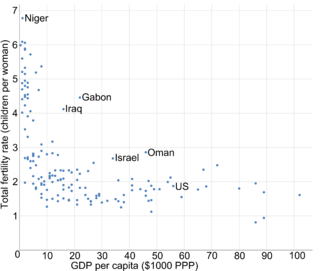
Social mobility is the movement of individuals, families, households or other categories of people within or between social strata in a society. It is a change in social status relative to one's current social location within a given society. This movement occurs between layers or tiers in an open system of social stratification. Open stratification systems are those in which at least some value is given to achieved status characteristics in a society. The movement can be in a downward or upward direction. Markers for social mobility such as education and class, are used to predict, discuss and learn more about an individual or a group's mobility in society.

National accounts or national account systems (NAS) are the implementation of complete and consistent accounting techniques for measuring the economic activity of a nation. These include detailed underlying measures that rely on double-entry accounting. By design, such accounting makes the totals on both sides of an account equal even though they each measure different characteristics, for example production and the income from it. As a method, the subject is termed national accounting or, more generally, social accounting. Stated otherwise, national accounts as systems may be distinguished from the economic data associated with those systems. While sharing many common principles with business accounting, national accounts are based on economic concepts. One conceptual construct for representing flows of all economic transactions that take place in an economy is a social accounting matrix with accounts in each respective row-column entry.
In economics, a cycle of poverty or poverty trap is caused by self-reinforcing mechanisms that cause poverty, once it exists, to persist unless there is outside intervention. It can persist across generations, and when applied to developing countries, is also known as a development trap.

The "Fed model" or "Fed Stock Valuation Model" (FSVM), is a disputed theory of equity valuation that compares the stock market's forward earnings yield to the nominal yield on long-term government bonds, and that the stock market – as a whole – is fairly valued, when the one-year forward-looking I/B/E/S earnings yield equals the 10-year nominal Treasury yield; deviations suggest over-or-under valuation.
In financial economics, finance, and accounting, the earnings response coefficient, or ERC, is the estimated relationship between equity returns and the unexpected portion of companies' earnings announcements.

Economic mobility is the ability of an individual, family or some other group to improve their economic status—usually measured in income. Economic mobility is often measured by movement between income quintiles. Economic mobility may be considered a type of social mobility, which is often measured in change in income.

Income and fertility is the association between monetary gain on one hand, and the tendency to produce offspring on the other. There is generally an inverse correlation between income and the total fertility rate within and between nations. The higher the degree of education and GDP per capita of a human population, subpopulation or social stratum, the fewer children are born in any developed country. In a 1974 United Nations population conference in Bucharest, Karan Singh, a former minister of population in India, illustrated this trend by stating "Development is the best contraceptive." In 2015, this thesis was supported by Vogl, T.S., who concluded that increasing the cumulative educational attainment of a generation of parents was by far the most important predictor of the inverse correlation between income and fertility based on a sample of 48 developing countries.

Socioeconomic status (SES) is an economic and sociological combined total measure of a person's work experience and of an individual's or family's economic access to resources and social position in relation to others. When analyzing a family's SES, the household income, earners' education, and occupation are examined, as well as combined income, whereas for an individual's SES only their own attributes are assessed. Recently, research has revealed a lesser recognized attribute of SES as perceived financial stress, as it defines the "balance between income and necessary expenses". Perceived financial stress can be tested by deciphering whether a person at the end of each month has more than enough, just enough, or not enough money or resources. However, SES is more commonly used to depict an economic difference in society as a whole.
The relationship between fertility and intelligence has been investigated in many demographic studies. There is evidence that, on a population level, measures of intelligence such as educational attainment and literacy are negatively correlated with fertility rate in some contexts. However, genetic studies have shown no evidence for dysgenic effects in human populations. Theories about dysgenic and eugenic effects in human populations have historically been associated with scientific racism.

Non-accelerating inflation rate of unemployment (NAIRU) is a theoretical level of unemployment below which inflation would be expected to rise. It was first introduced as NIRU by Franco Modigliani and Lucas Papademos in 1975, as an improvement over the "natural rate of unemployment" concept, which was proposed earlier by Milton Friedman.
Education economics or the economics of education is the study of economic issues relating to education, including the demand for education, the financing and provision of education, and the comparative efficiency of various educational programs and policies. From early works on the relationship between schooling and labor market outcomes for individuals, the field of the economics of education has grown rapidly to cover virtually all areas with linkages to education.

Real business-cycle theory is a class of new classical macroeconomics models in which business-cycle fluctuations are accounted for by real shocks. Unlike other leading theories of the business cycle, RBC theory sees business cycle fluctuations as the efficient response to exogenous changes in the real economic environment. That is, the level of national output necessarily maximizes expected utility, and governments should therefore concentrate on long-run structural policy changes and not intervene through discretionary fiscal or monetary policy designed to actively smooth out economic short-term fluctuations.

A share price is the price of a single share of a number of saleable equity shares of a company. In layman's terms, the stock price is the highest amount someone is willing to pay for the stock, or the lowest amount that it can be bought for.

The correlates of crime explore the associations of specific non-criminal factors with specific crimes.

Socioeconomic mobility in the United States refers to the upward or downward movement of Americans from one social class or economic level to another, through job changes, inheritance, marriage, connections, tax changes, innovation, illegal activities, hard work, lobbying, luck, health changes or other factors.
Second-generation immigrants in the United States are individuals born and raised in the United States who have at least one foreign-born parent. Although the term is an oxymoron which is often used ambiguously, this definition is cited by major research centers including the United States Census Bureau and the Pew Research Center.
Female foeticide in India is the abortion of a female foetus outside of legal methods. A research by Pew Research Center based on Union government data indicates foeticide of at least 9 million females in the years 2000-2019. The research found that 86.7% of these foeticides were by Hindus, followed by Sikhs with 4.9%, and Muslims with 6.6%. The research also indicated an overall decline in preference for sons in the time period.

The "Great Gatsby Curve" is the term given to the positive empirical relationship between cross-sectional income inequality and persistence of income across generations. The scatter plot shows the relationship between income inequality in a country and intergenerational income mobility.
First-generation college students in the United States are college students whose parents did not complete a baccalaureate degree. Although research has revealed that completion of a baccalaureate degree is significant in terms of upward socioeconomic mobility in the United States, a considerable body of research indicates that these students face significant systemic barriers to postsecondary education access, academic success once enrolled, and degree completion. Many of these obstacles result from systemic racial, cultural, social, and economic inequities.
The spoon class theory refers to the idea that individuals in a country can be classified into different socioeconomic classes based on the assets and income level of their parents, and as a consequence, one's success in life depends entirely on being born into a wealthy family. The term appeared in 2015 and was first widely used among online communities in South Korea.








